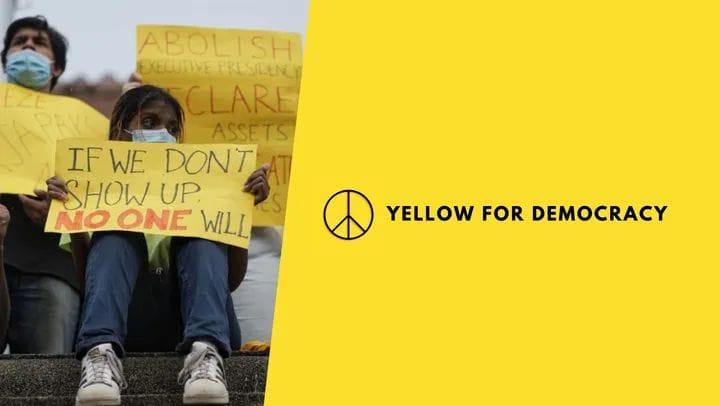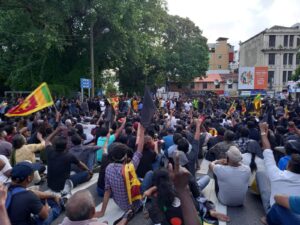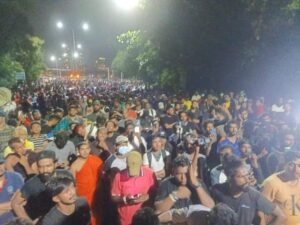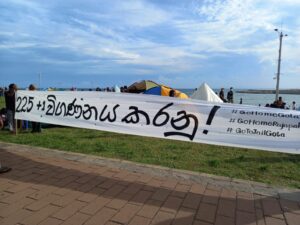
On 4th April 2022, Independence Square was filled with an estimated 8000 people, possibly in one of the biggest political gatherings the square has seen in recent times. Most of them were young people reiterating the call reverberating through a number of smaller protests across Colombo in the month of March—for President Gotabaya Rajapaksa to “Go Home!” and an end to the Executive Presidency. Treshan Fernando from Polity spoke to 19-year-old Serika Siriwardhana, from Colombo, one of the main organisers of this protest, who went on to establish Yellow for Democracy, a youth organisation with the goal of raising awareness of the current economic and political crisis and mobilise youth for action. In this conversation, she explains how the protests were organised, the day after the government lifted a curfew that it had imposed the previous day, the effect she hopes the protests have had and will have on the youth, and the transformations she wants to see in our democracy.
Q: Tell me about yourself and what made you organise these protests.
I’m Serika and I am 19 years old. I went to Ladies’ College for my entire academic career except for my Advanced Levels which I did at Elizabeth Moir School. I am on my gap year and I’m going to Cambridge in September to study human, social, political sciences. One of the immediate reasons that I got involved in this protest was because there seemed to be very little engagement (with the economic crisis) amongst the youth, including my friends and the people I know.
When curfew was imposed on the 3rd of April and the Independence Square protest that was called on that day got cancelled, I felt very confused. I decided that since we all had no idea what was going to happen, we might as well do something, plan something, and it doesn’t matter how many people turn up, we have to make the crowd. I felt inspired to mobilise people whom I know, who are otherwise mostly politically apathetic.
We decided to organise a protest after curfew on the 3rd because we wanted to express dissent as the youth. It really just started with friends and family, but it gained a lot of traction. On the 4th of April, there were so many people who came and protested with us. So we decided to create the Yellow for Democracy Instagram page just to document the youths’ thoughts; what they want from the future, why they’re there, and how they think we can move forward in the country.
Q: What does Yellow for Democracy stand for?
Yellow for Democracy is an entirely youth-based organisation, led by the youth, for the youth. It came about completely naturally. It was only a bunch of friends and family.
But then we got a huge amount of momentum and traction on our Instagram page. We had around 1,000 followers in less than a week. So we tried to figure what we were going to do with this platform. What are we actually calling for? We realised that it’s important to combine the dissent with information dissemination as well because there’s so much that we, and the youth in the country, don’t know about the political situation, the economic system, the constitutional situation. It’s because of this lack of awareness that we’re in this current situation.
Our members are all youth. We got so many volunteers who were very interested in working with Yellow for Democracy. The reason we selected yellow is because it is symbolic of democracy. It also symbolises freedom, hope, and also in the context of Sri Lanka, unity. In our flag, the yellow border is symbolic of unity. So yellow encompasses all of these ideas, as well as a brighter future which is quite intrinsic to the fact that this is a youth led movement.
Q: You organised a few protests starting from April 4th. Can you tell a bit about who exactly came for it and whether it was difficult to get people to continue to join these protests?
The first protest was very easy to get people to join because, as I said, the day before that they had planned a massive protest at Independence Square and that was cancelled following curfew. I don’t think there was much information regarding protests on Monday [4th of April]. People were very enthusiastic about coming on Monday because it gave them the opportunity to express the frustration that they planned to express on Sunday the 3rd but weren’t able to. People were very annoyed by the government’s decision to impose curfew on the 3rd and so I think there was an environment where it was very easy to mobilise people.
As to how we mobilised people to join, for the protests on the 4th of April I put up a story on my Instagram page and it spread like wildfire. I also sent messages to people and lots of people were interested. I created a WhatsApp group but that reached maximum capacity, so I had to create a second one. We had around 500 people on the WhatsApp groups alone. So, it was very much social media based and through word of mouth.
The sort of people who came with Yellow for Democracy was very much the Colombo 7 crowd; that was the demographic at the beginning. But we merged with a couple of other protests later that day. Those were university students and that exposed us to some very powerful leaders at the forefront of protests. It was a great opportunity to meet and interact with people that we would otherwise not have had the chance to meet. I recognise that young people from different classes are involved and that we all carry certain preconceived notions about other classes and demographics.
Monday was amazing because there were these people who would otherwise never have let themselves be led in protest by someone like me, enthusiastically engaging with and listening to what I had to say. I think that was one of the most beautiful things about the Monday protest.
The 4th Monday protest was followed by protests on the 8th, 13th, and 14th of April. There was a lot of enthusiasm for the one on the 8th as well, but it was pretty rainy on that day. In the morning there were quite a few people protesting in the rains as well, but it picked up over the evening when the LGBTQ community protesters joined the protests at Independence Square and the Muslim community came for Ifthar. That was one of the most heart-warming moments of the protest.
Q: You said that people around you were apathetic. Were they still apathetic on April 4? If they weren’t by then, what changed?
I think the unique aspect of these protests and our current situation is that it affects every single person in the country, regardless of their class, gender, race or religion. The situation is such that it is impossible to be apathetic because everybody is affected by it, which is why there’s so much momentum all over the country, regardless of any divisions of demographics.
I definitely think that people are getting more involved, especially people who have been privileged thus far and have been unaffected by other things that people protest for. Even they are being affected and so there is less apathy. People are aware that they need to learn more. We have seen a lot of interest and a lot of questions coming in to Yellow for Democracy asking about various things. So, there is a lot of engagement and I do think that political apathy has reduced a lot.
But I hope that this political involvement doesn’t only last as long as there’s gas shortages and electricity cuts. The problem persists, and Sri Lankans are quite short-sighted sometimes. So, once this problem is solved, which will admittedly take a long time, my fear is that we won’t remember why we got into this situation in the first place and go back to being politically apathetic. But I really hope that doesn’t happen. That’s why we’re doing a lot of what we’re doing with Yellow for Democracy because we want to create that long term mindset shift, especially amongst the youth.
Q: In your promotional material you had asked people not to swear and refrain from certain words and chants. Was that to promote a form of inclusive protesting?
This was actually in response to the protest on Monday the 4th of April. There was a point where people started chanting the Gotabaya P-word chant and there were children in the crowd. So we went up to them and asked them not to do that and pointed out that there were children present. They took that onboard pretty well and there wasn’t any backlash to that.
To be honest it was mostly to be inclusive of the children there but also because we wanted to be mindful of the things that were said at these protests. There are a lot of chants that are very catchy, and people love doing them obviously, but we wanted to avoid swearing, profanity, and personal attacks even though the protest is looking to express our anger.
Q: What kind of organisations and movements engaged in the protests were you part of?
One of the biggest issues with the protests is that there is very little central organisation. People come as groups or if it’s shared on social media, but there weren’t really any organisations as such. Especially the one on the 4th of April, people were just out to protest—the LGBTQ communities, Muslim communities, student communities from various universities. There are those groups. But we have noted that what we really need is some sort of cohesiveness between these groups. We’re trying to figure out a way to make it more cohesive so we can be more coordinated and make it more effective.
Q: What is Yellow for Democracy‘s involvement in the recent Galle Face protests?
All of our protests have been organised at Independence Square but lots of people have reached out to us about donating and giving supplies to protestors. So we have a collection point at Galle Face and we have a lot of donations that come through Yellow for Democracy. We’re often there helping out with donations and sending supplies to protestors. But we have not organised protests specifically at Galle Face.
Q: What exactly are the reforms that you are asking for? Ideally, what would you want to see as a result of these protests?
The main aim of our group is to not only protest but to educate. And in educating other people we have to educate ourselves as well. We’re youth. We don’t know as much as we can or should about politics. So we have been talking to several legal, political, constitutional, and economic experts and leaders in their fields because we want to know what we’re talking about before we disseminate that information to other people.
The short-term goal, the first step towards change, is to call for the resignation of President Gotabaya under Article 38(1)(b) of the Constitution and, subsequently, for Parliament to elect a President under Article 40 of the Constitution, with the condition that the President elected by Parliament is not a Rajapaksa. The explanation being that, with a country of 22 million people, it is impossible to justify that 6 people in politics are from the same family. It doesn’t make sense for the country to be led by a family which takes up a completely disproportionate part in leadership.
That’s our first call because without President Gotabaya resigning there’s no step forward. Even if the premiership is changed, even if the Cabinet is reshuffled, even if new appointments are made, they are not going to be able to do anything as long as the current President has executive powers.
But that is just the short-term plan. In the long term, we recognise that the issue here is not with one party, one person or one family. The issue is systemic. It is cultural. And we also must recognise that we as a country are to blame for the leaders we have in place because we voted them in. It’s because of allowing decades of corruption and nepotism to spiral completely out of control that an environment has been created in which people such as the Rajapaksa family or anybody in government are able to thrive. It makes it impossible for people who are educated or moral to come into power, because people who wish to change things have to subscribe to the very things that they want to change in order to come into power. It is impossible to come into power without being corrupt, without calling in favours. So anybody with a conscience, and wants to change the system, cannot come into power by any other means than those very same things they want to change.
So, the system is incredibly corrupt and as a culture, as citizens, we need to be more politically aware and engaged, without just voting based on inherited politics or short-term gains. Long term change must be systemic and is tied integrally to educating people.
Q: Some people and even some MPs have said that the people are protesting not just against the Rajapaksas, but also against all 225 MPs in Parliament. Do you agree with that?
People are using that narrative to deviate from the crux of the problem. I think that the immediate problem is definitely the Rajapaksa family. But even if we move forward, we are going to have to choose our Cabinet and leaders from the existing 225. So we can’t get rid of all 225 because constitutionally that’s impossible. But I would argue that all 225 are corrupt and have benefited from a corrupt system including the people that Sri Lanka seems to have agreed should be in positions of power moving forward. Even though they may not have been corrupt themselves, they have definitely been within an environment that is corrupt, witnessing corruption, and not said anything about it because they stand to gain by being silent. The idea is that silence is compliance.
There’s no point being un-corrupt, educated, erudite, if you’re not going to be vocal about your beliefs and your views. I would definitely say that the system itself does not allow for good people to thrive and anybody who does thrive in the system has had to subscribe in one way or another to something that is morally corrupt. I am personally of the view that all 225 are problematic. But we do have to work with those 225. We need to register that, it is true they’re all corrupt, but until we get out of this situation, we must agree that educated people, and people who know what they’re talking about, should be chosen out of those 225. We can subsequently deal with the issue of silence and compliance.
Q: The government has declared two public holidays and there are several days of holidays ahead. Do you think protests will continue after the New Year?
From what I’ve heard, the people in power are quite confident that these things will die down come avurudu and the holidays. I think they’re taking it for granted that this will not extend past New Year. People are aware that this is what the people in power think and because of that, hopefully, the momentum will continue.
We have had discussions about protests and how to carry them forward. There are ideas of celebrating avurudu at protests themselves. You know, coming together in the same way that all of us were there for Ifthar. For all of us coming together and celebrating avurudu as a united nation, that is a very interesting idea and I do hope that happens. We’re trying to make that happen. But I think the anger of the people is intense because 22 million people have been united in their hatred of this one family. We’ve come to this point in our history where it’s just impossible for us to move forward as a country. So I think that unity will continue for as long as people are suffering in this situation, and people are going to keep suffering because there is no immediate solution to any of this.
I hope that the momentum is maintained but I also think that it’s impossible to expect that we will keep protesting forever. We also have to educate ourselves to know exactly what we’re asking for so we can, as a nation, make a concerted effort to come together and make constructive demands of the government. That can only happen if we educate ourselves and that is the only way we can keep the momentum going. That is one of the things we at Yellow for Democracy are doing. We’re trying to share knowledge with the youth who follow our platform because we think that is integral to maintaining political momentum.
Q: Do you have anything else to say regarding the protests that have happened or what you want to see done in the country?
On the nature of protests, there’s been a lot of criticism on how protests have been carried out, with people talking about ‘Big Match’ energy and things like that, especially the one on Monday which garnered a lot of criticism. We were there from 7:30 in the morning to 7:30 at night and we’re just human. With people, there has to be a certain level of energy or boosts that need to happen. It is understandable that people were there with their rabban and their rabban bata chants. But we definitely need to be focused on striking that delicate balance between being able to maintain our momentum as well as remembering why we’re there. Because by the end of Monday the 4th of April I personally felt that it was too much of a carnival vibe. But again that was because there were so many people in one place that it was impossible for anything constructive in terms of what they were chanting or what they were saying to happen. You can’t manage 8,000 people.
For the people criticising how it worked, I would say it’s important to think of human nature and the practicalities of things. But also, I would say to people protesting that it’s important that they don’t go into these protests with the mindset that ‘oh this is a party’ or ‘I’m just going to have some fun with my friends.’ There’s a very real reason we’re here and there’s a very real impact on people’s lives. People are dying and not able to carry out their daily lives. The very act of protesting is a privilege because we’re able to take time off and go to the streets. We’re fighting for the people who can’t do that. So it’s disrespectful to go into it with the mentality that this is athal or this is fun.
I think striking that balance is very important and maintaining momentum is also very important; as is educating ourselves about change that needs to be brought about, and what we need to do and ask for in order for that to happen.



